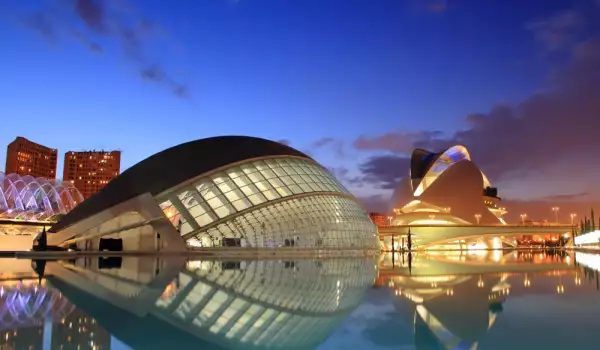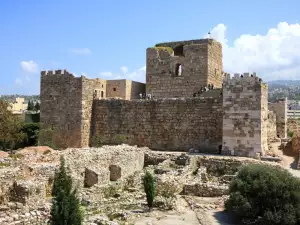City of Arts and Sciences in Valencia

City of Arts and Sciences in Valencia is a unique mega complex modernist architecture, which embodies the modern face of this beautiful Spanish city. The huge complex is situated in a landscaped park with ponds, entertainment, sport and recreation. The City of Arts and Science is a cultural and architectural complex, which is one of the main attractions of the city. Here one can simultaneously entertain, educate and obtain new knowledge.
The architectural complex was built in the late 20th century, on the right bank of the old Turia riverbed. After a disastrous flood in 1957 the river has shifted into a new bed south of the city and the old one is transformed into a park with a length of 10 kilometres. The city of art and science embodies the latest developments in architecture and culture, a symbol of the future development of Valencia, amidst a charming city park.
Designers of the city of art and science are the world famous Santiago Calatrava and Felice Candela. The complex of five buildings is set in a contemporary style: Palau de les Arts, the largest aquarium in Europe (L'Oceanogràfic), an interactive science centre, planetarium (L'Hemisfèric), IMAX cinema and a botanical garden (L'Umbracle). All buildings are built in a unique futuristic style, with lots of windows, rounded, bright facades and this is just the beginning.
The City of Arts and Science was built to commemorate the new millennium, and today is a world famous scientific, cultural and entertainment centre. One can walk here for hours without being bored. The architect himself said: "I am proud that people can walk through this free attraction. This is the best way to detect a complex message". The renowned architect, artist and engineer, designed the 7 km long promenade that surrounds the City of Arts and Sciences in Valencia.
The ambitious project began in late 1994 and in about 2-3 years was completed. The idea to build a large modern complex was conceived in the late 80s of last century. Today this town of modernist culture and science consists of a hemisphere, including IMAX cinema and planetarium with an area of 13, 000 square meters, resembling the shape of an eye. The giant cinema is 900 m long.

Another part of the City of Arts and Science Museum of Science is "Prince Felipe" of 2000, representing an interactive science museum, whose shape resembles the skeleton of a whale and occupies an area of 40, 000 square meters, built on three levels. L'Oceanogràfic is the largest oceanographic aquarium in Europe. Spread over an area 110, 000 square meters, which uses 42 million litres of water in which live 45, 000 animals of 500 species. It is built in the shape of a water lily, designed by Felix Candela.
Palau de les Arts, known as the Palace of Arts "Reina Sofia" (2005) is dedicated to music and performing arts. Here the opera of Valencia is housed. Remarkable part of the complex City of Arts and Science Agora is a covered square which hosts concerts and sporting events. Its height reaches 80 meters, has an area of 5000 square meters and seats 6, 000 spectators. I can not miss the Bridge and Puente de l'Assut de l'Or, which connects the southern end of street Minorka and whose 125-meter poles are the highest point in town.
Towers of Valencia are part of a project to build three skyscrapers to the ensemble of the city of art and science. They must be high, respectively 308, 266 and 220 meters, but for now their construction is frozen. City of Arts and Science is open to the public every day from 10.00 to 18.00, with front desks close one hour earlier. Depending on the tourist season, the complex can operate up to 20, 21 or 24 pm Tickets for the hemisphere and the Museum of Science are € 7.50, while for L'Oceanogràfic - € 23.90. A combined ticket costs € 31.60.















